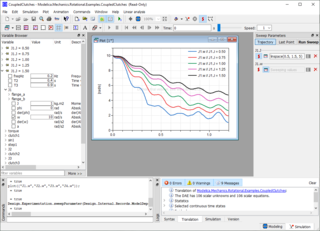The following code fragment shows a very simple example of a first order system ( ):
):
modelFirstOrderparameterRealc=1"Time constant";Realx(start=10)"An unknown";equationder(x)=-c*x"A first order differential equation";endFirstOrder;
modelsecond_derivativeReall;Realz=sin(w*time);Realm;parameterRealw=1;equationl=der(z);m=der(l);endsecond_derivative;
The main application area of Modelica is the modeling of physical systems. The most basic structuring concepts are shown at hand of simple examples from the electrical domain:
Basic model components
A basic model component is defined by a model and contains equations that describe the relationship between the connector variables in a declarative form (i.e., without specifying the calculation order):
modelCapacitorparameterCapacitanceC;Voltageu"Voltage drop between pin_p and pin_n";Pinpin_p,pin_n;equation0=pin_p.i+pin_n.i;u=pin_p.v-pin_n.v;C*der(u)=pin_p.i;endCapacitor;
The goal is that a connected set of model components leads to a set of differential, algebraic and discrete equations where the number of unknowns and the number of equations is identical. In Modelica, this is achieved by requiring so called balanced models.
The full rules for defining balanced models are rather complex, and can be read from [1] in section 4.7.
However, for most cases, a simple rule can be issued, that counts variables and equations the same way as most simulation tools do:
A model is balanced when the number of its equations equals the number of its variables.
given that variables and equations must be counted according to the following rule:
->Number of model equations = Number of equations defined in the model + number of flow variables in the outside connectors ->Number of model variables = Number of variables defined in the model (including the variables in the physical connectors)
Note that standard input connectors (such as RealInput or IntegerInput) do not contribute to the count of variables since no new variables are defined inside them.
The reason for this rule can be understood thinking of the capacitor defined above. Its pins contain a flow variable, i.e. a current, each. When we check it, it is connected to nothing. This corresponds to set an equation pin.i=0 for each pin. That's why we must add an equation for each flow variable.
Obviously the example can be extended to other cases, in which other kinds of flow variables are involved (e.g. forces, torques, etc.).
When our capacitor is connected to another (balanced) model through one of its pins, a connection equation will be generated that will substitute the two i=0 equations of the pins being connected. Since the connection equation corresponds to two scalar equations, the connection operation will leave the balanced larger model (constituted by our Capacitor and the model it is connected to).
The Capacitor model above is balanced, since
number of equations = 3+2=5 (flow variables: pin_p.i, pin_n.i, u) number of variables = 5 (u, pin_p.u, pin_p.i, pin_n.u, pi_n.i)
Verification using OpenModelica [16] of this model gives, in fact
Class Capacitor has 5 equation(s) and 5 variable(s). 3 of these are trivial equation(s).
Another example, containing both input connectors and physical connectors is the following component from Modelica Standard Library:
modelSignalVoltage"Generic voltage source using the input signal as source voltage"Interfaces.PositivePinp;Interfaces.NegativePinn;Modelica.Blocks.Interfaces.RealInputv(unit="V")"Voltage between pin p and n (= p.v - n.v) as input signal";SI.Currenti"Current flowing from pin p to pin n";equationv=p.v-n.v;0=p.i+n.i;i=p.i;endSignalVoltage;
The component SignalVoltage is balanced since
number of equations = 3+2=5 (flow variables: pin_p.i, pin_n.i, u) number of variables = 5 (i, pin_p.u, pin_p.i, pin_n.u, pi_n.i)
Again, checking with OpenModelica [16] gives
Class Modelica.Electrical.Analog.Sources.SignalVoltage has 5 equation(s) and 5 variable(s). 4 of these are trivial equation(s).









